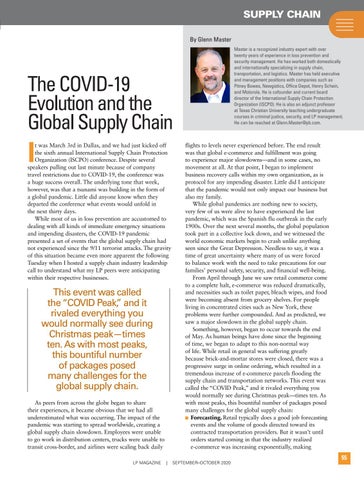SUPPLY CHAIN By Glenn Master Master is a recognized industry expert with over twenty years of experience in loss prevention and security management. He has worked both domestically and internationally specializing in supply chain, transportation, and logistics. Master has held executive and management positions with companies such as Pitney Bowes, Newgistics, Office Depot, Henry Schein, and Motorola. He is cofounder and current board director of the International Supply Chain Protection Organization (ISCPO). He is also an adjunct professor at Texas Christian University teaching undergraduate courses in criminal justice, security, and LP management. He can be reached at Glenn.Master@pb.com.
The COVID-19 Evolution and the Global Supply Chain
I
t was March 3rd in Dallas, and we had just kicked off the sixth annual International Supply Chain Protection Organization (ISCPO) conference. Despite several speakers pulling out last minute because of company travel restrictions due to COVID-19, the conference was a huge success overall. The underlying tone that week, however, was that a tsunami was building in the form of a global pandemic. Little did anyone know when they departed the conference what events would unfold in the next thirty days. While most of us in loss prevention are accustomed to dealing with all kinds of immediate emergency situations and impending disasters, the COVID-19 pandemic presented a set of events that the global supply chain had not experienced since the 9/11 terrorist attacks. The gravity of this situation became even more apparent the following Tuesday when I hosted a supply chain industry leadership call to understand what my LP peers were anticipating within their respective businesses.
This event was called the “COVID Peak,” and it rivaled everything you would normally see during Christmas peak—times ten. As with most peaks, this bountiful number of packages posed many challenges for the global supply chain. As peers from across the globe began to share their experiences, it became obvious that we had all underestimated what was occurring. The impact of the pandemic was starting to spread worldwide, creating a global supply chain slowdown. Employees were unable to go work in distribution centers, trucks were unable to transit cross-border, and airlines were scaling back daily LP MAGAZINE
|
flights to levels never experienced before. The end result was that global e-commerce and fulfillment was going to experience major slowdowns—and in some cases, no movement at all. At that point, I began to implement business recovery calls within my own organization, as is protocol for any impending disaster. Little did I anticipate that the pandemic would not only impact our business but also my family. While global pandemics are nothing new to society, very few of us were alive to have experienced the last pandemic, which was the Spanish flu outbreak in the early 1900s. Over the next several months, the global population took part in a collective lock down, and we witnessed the world economic markets begin to crash unlike anything seen since the Great Depression. Needless to say, it was a time of great uncertainty where many of us were forced to balance work with the need to take precautions for our families’ personal safety, security, and financial well-being. From April through June we saw retail commerce come to a complete halt, e-commerce was reduced dramatically, and necessities such as toilet paper, bleach wipes, and food were becoming absent from grocery shelves. For people living in concentrated cities such as New York, these problems were further compounded. And as predicted, we saw a major slowdown in the global supply chain. Something, however, began to occur towards the end of May. As human beings have done since the beginning of time, we began to adapt to this non-normal way of life. While retail in general was suffering greatly because brick-and-mortar stores were closed, there was a progressive surge in online ordering, which resulted in a tremendous increase of e-commerce parcels flooding the supply chain and transportation networks. This event was called the “COVID Peak,” and it rivaled everything you would normally see during Christmas peak—times ten. As with most peaks, this bountiful number of packages posed many challenges for the global supply chain: ■ Forecasting. Retail typically does a good job forecasting events and the volume of goods directed toward its contracted transportation providers. But it wasn’t until orders started coming in that the industry realized e-commerce was increasing exponentially, making SEPTEMBER–OCTOBER 2020
55







